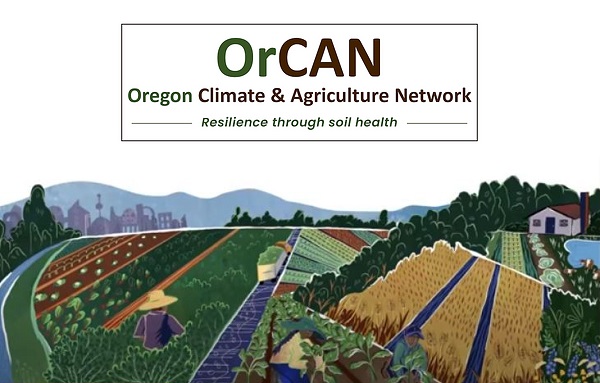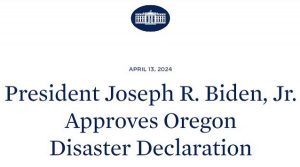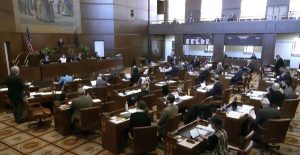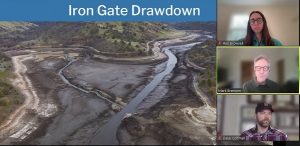Oregon Climate & Ag Network: This Earth Day, thank a farmer
13 min read
This Earth Day, thank a farmer.
Carly Boyer (Oregon Climate and Agriculture Network – OrCAN): I’m a fourth-generation Oregonian and my father was a farmer. I come from a farming family. And so, I just really have always cared about the farmer experience and how challenging it is for them to be successful. My dad actually discouraged me from becoming a farmer, because of the hardships that he experienced.
And so I can’t help it. I love people who are close to the earth, and I just really want to advocate for farmers so that they can be successful. Without farmers, we have no food and they do a lot of ecological services stewarding the land. And now that we’ve made it really clear that we need to do this carbon drawdown, the agricultural sector can actually sequester carbon.
And that’s possible. That’s attainable. We can really do that as a community. And so we need to support farmers so they can be successful in having healthy soils.
[00:01:13] Oregon Climate and Agriculture Network works with farm service providers, farmers, and ranchers, and a lot of the support organizations to both advocate, educate, climate-friendly farming practices across Oregon. We have a network of over 1,000 people in Oregon, and right now we’re really working with our partner organizations, and that includes Soil and Water Conservation Districts, Natural Resources Conservation Service, Oregon Association of Conservation Districts, and OSU Extension.
[00:01:57] We’re building a soil health network, and this collaboration is designed to increase access to folks who have traditionally had a hard time accessing funding to implement those farming strategies. They may need specialized equipment, like manure spreaders or no-till drills, and they may not have capacity to purchase those pieces of equipment. And there may be other barriers, just like capacity, time, and planning to be able to do the work.
[00:02:35] I think most farmers are really interested in increasing conservation practices on their working lands but there are various barriers to just doing it. So we are trying to eliminate some of those barriers and make it easier for farmers to implement those practices.
[00:02:50] Because climate-friendly farming practices have a lot of benefits and some of those are: water recharge in local aquifers, carbon sequestration, reducing greenhouse gas emissions, as well as increasing biodiversity in both plants and animals.
[00:03:12] And it can increase production, increase products, so it’s overall benefit for an operation as well. It can increase the bottom line. So there’s a lot of benefits, but sometimes the barriers just get in the way of implementing that. And that’s why there’s a lot of coordination right now between the different service organizations to try and make it easier for farmers to do that work.
[00:03:41] There’s a lot of various service organizations in the Oregon landscape, and that’s great because there’s a lot of existing resources, but it can be overwhelming at times for farmers to know where to even start.
[00:03:51] We’re just trying to make it a lot easier. Part of how we’re able to do that is by providing climate resilience training for Oregon’s farm service providers.
[00:04:01] I have an advisory council and that’s made up of staff from Oregon Watershed Enhancement Board, different Soil and Water Conservation Districts, OSU Extension, many other partners. And we, I just really listen to them, like: Where are they seeing the gaps? What do their communities and what do their staff people need in outside training? Sometimes these organizations can’t provide additional educational opportunities, and so as an outside organization, OrCAN, we can find those people that are bringing out the most recent research.
[00:04:44] So I brought on a few different PhD researchers to share about their work in connecting how to understand farmer perceptions and how farmers best communicate, like how to reach them through peer-to-peer networks.
[00:05:05] This last fall I had a successful three-part webinar and over 200 farm service providers attended, and that was largely highlighting recent research out of the universities and talking about successful working groups to address drought conditions and generally sharing what we’re learning and what’s effective and how to support farmers with the most recent research.
[00:05:37] John Q: Here are a few excerpts from those webinars, available on YouTube.
[00:05:43] Margiana Peterson-Rockney (OrCAN November 2023 Session 1): One key finding of my research is that many farmers also perceive social risks associated with climate change. The minority of farmers who did share their beliefs in anthropogenic climate change with me only did so after assurances of anonymity, like this cattle rancher who said: ‘I want you to know that I do believe in climate change, but it’s important that you not tell my neighbors that I believe in climate change,’ and this was several hours into this conversation.
[00:06:12] In a community where climate disbelief is a strongly held cultural norm, farmers worry they’d be ostracized if they were associated with climate change, especially established farmers were worried about losing access to the benefits of what rural sociologists call ‘norms of neighborliness.’
[00:06:32] These are the informal norms that people in rural communities rely on, like reciprocal labor exchanges or the ability to herd their cows across each other’s land. And some farmers also worried about being excluded from formal networks and institutions.
[00:06:51] Melissa Parks (OrCAN November 2023 Session 1): I spoke to small farmers across Oregon, across these kind of five different ecoregions of Oregon… It was really interesting to find that despite farmers being spread out across the state, they really were noticing a lot of the similar weather-related challenges. So, despite a farmer being an Eastern Oregon versus the Willamette Valley, versus the Columbia Plateau, a lot of the weather-related challenges they were dealing with were very similar. And the most common ones were things like variability in the timing of precipitation, drought, extreme heat, and variability in frost dates.
[00:07:28] I found that farmers were highly reliant on their interactions with various crops and animals, as well as wild animals and wild plants, things like the soil and bodies of water, rivers, to get their understanding of what was happening in the climate. So essentially, their observations of what was happening with their crops and with their animals and the rivers, etc., was really communicating to them that something extreme was happening, that what was going on with the weather was not normal.
[00:07:58] I have a quote here from a farmer where he said, ‘What was really, really scary this summer was I’ve never seen the Siletz River so low.’ So kind of his observations over the years of the river and seeing how low it got one summer during a drought really kind of communicated to him that things were extreme and this was much more variable.
[00:08:33] Another really interesting finding: So farmers that were more diversified on their farm, essentially, and more interacting with various animals and various crops and had an orchard, those farmers were noticing more types of weather extremes and challenges. So they were noticing drought and changes in frost dates and changes in precipitation versus farmers that were a little bit more focused on just one or two commodities.
[00:08:44] They tended to not be noticing as many weather challenges. So this just speaks a little bit to the importance of diversity and having diversified farms. The more crops and animals that are present on people’s farms, the more they’re able to notice like, ‘Oh, wow, this frost really affected my squash in this way.’ So it just kind of really opened up to them a deeper breadth of observation in terms of what was going on in the weather.
[00:09:09] Berit Dinsdale (OrCAN November 2023 Session 2): So if you were in Oregon or in the Pacific Northwest, you’ll remember that in 2020 we had that heat dome and that really terrified all of us, I think. So a follow-up, a December 2021 special legislative session was held, to talk about different kind of emergency responses to drought and heat and climate challenges. What are farmers doing already to deal with drought and heat? And then also what would they like to be able to do moving forward?
[00:09:36] Some of the more kind of prevalent activities were applying water to reduce heat impact. Of course, when we have more drought, we often have more heat. And so trying to cool down your crops with more limited water is extremely challenging, right?
[00:09:51] Folks also said that they would like to be able to drop their wells deeper or dig new wells. And then there was also a call for increasing off-farm infrastructure development like large-scale reservoirs. Some obstacles in this regard though were things like water access and efficacy.
[00:10:07] Shade structures are something that especially fresh market producers were really interested in. Here in the (Willamette) Valley, berry producers were actually spending upwards of $1 million looking into shade structures because they feel like they don’t have very many options anymore.
[00:10:20] When it came to dropping or digging new wells, folks would like more accurate or better communicated data about things like water availability. So it wouldn’t necessarily be a solution, but I think it would foster better relationships between policymakers, regulatory groups, and farmers if farmers felt like, how much water is available, and why they can’t drop a new well or put in water storage, it wouldn’t necessarily be a solution, would maybe help them feel a little bit better about those calls.
[00:10:49] A lot of the issues with soil came back to things, especially for smaller scale producers, but for larger scale as well, a lack of access to appropriate equipment. So if you only have a couple acres, it might be not be worthwhile for you to get a no-till drill, for example, right? There are some really great programs out there that will rent equipment, and there was some call to explain those programs to other soil and water conservation districts. Mulching and composting folks said, ‘We don’t know where to get the resources from.’ Maybe there could be some seed funding for businesses that provide leaf litter to farmers for really cheap. So accessing more affordable mulch mulch and compost inputs.
[00:11:27] And soil moisture monitoring. This one was pretty interesting to us because it’s something that we’ve talked about in extension for a little while. Folks are aware of soil moisture monitoring as a strategy. However, the cost of the equipment, installing them all over the property, if you have a lot of variability, it can be very expensive. But one of the main things that I wanted to draw attention to was the data interpretation.
[00:11:51] I think we all know this, that we have a very, like, narrow window of time when you’re farming. And being able to sit down, look at data and then create actionable items is not something that a lot of farmers can do or want to do. So we can give people data, but we also need to give them tools and strategies on how to interpret and use that data.
[00:12:10] Hailey Wilmer (OrCAN November 2023 Session 3): And actually ranchers said, you know, we’re pretty good at ranching. We’re pretty good at adapting to ecological change. Drought is a thing we deal with all the time. We can deal with grazing management. We can deal with water infrastructure.
[00:12:22] What we don’t have tools to deal with are the economic conditions of our industry, the changes we’re experiencing in our communities, and this competition for rangeland use, whether it’s private or public land we’re dealing with; just more complexity around people that want access or want to use or want to buy the lands that we graze on. We don’t know what to do about those things necessarily.
[00:12:45] So, we had some great quotes. Ranchers can give you some pretty colorful quotes, talking here about things that you can control and things that you can’t. I just have time to read the last quote here about the economics of the beef industry. A rancher from Northern Utah said, ‘I played with everything to try to get my cattle to where I think it will work. And it’s a challenge. Is the juice worth the squeeze? All the effort you go into it, do you see the return?’
[00:13:10] The pretty low profit margins and a long-term economic squeeze on these folks makes it just a really challenging environment. And how do you ask ranchers to think about making change in that space when they have all these other things going on?
[00:13:29] Ellen Hammond (OrCAN November 2023 Session 3): Agriculture drives the Jefferson County economy and the culture. It’s a perfect place for growing seeds, if you have irrigation. We have an international market for our seeds. If you bought a seed for a carrot from a grocery store, there’s a good chance that seed came from our area. If you’re watching an NFL or Major League Baseball game on turf, there’s a good chance that that turf seed came from our area. And the monarch butterflies in the Midwest are landing on wildflowers that were grown in our area. We also have about 20,000 beef cattle that are raised and sold annually.
[00:14:16] And so the agricultural economy is critical for Jefferson County. But we also have drought… It takes a little over two acre-feet in order to reasonably grow a crop in Jefferson County and the irrigation district last year allocated a quarter of that resulting in 40% fallow fields, while irrigators tried moving water from one field to another to try to equal the amount of water it took to raise a crop… Now, our ranchers are also getting affected. Well levels are dropping and it’s getting harder to do the kind of ranching that they have done for so long.
[00:14:59] And in the fall of last year, I asked if we had a long-range plan for drought. And we didn’t, so I started asking folks: Do we need a long-range plan? And the answer was yes, so I started facilitating it
[00:15:14] Jesse Nichols (CAMPO Collective, OrCAN November 2023 Session 2): The most environmentally destructive forms of conventional agriculture are tied to exploitative social practices, treating both the land and people as means of profit. They have to be addressed simultaneously, in our opinion. We can do a lot to look at the existing structure and try to make it more sustainable. But if we’re not looking to change the social and economic structures that cause so much environmental damage, it’s really hard to fit a square peg in the round hole and make those structures just become more environmentally sustainable because it’s not their business model.
[00:15:53] So CAMPO organizes farm workers from conventional farming backgrounds into cooperative sustainable social structures. And the people in CAMPO, other than myself, everybody else comes from situations in Latin America where they have farmed for many years. Their families have a lot of experience and we’re missing out on a whole bunch of valuable knowledge.
[00:16:15] So the practices that we tried to integrate into our farm include no tillage, deep compost mulching, permaculture. We have a lot of perennials planted in with our annuals. We’re working on integration of goats and egg-laying chickens, rotating back and forth between animal pastures and vegetable pastures. And of course, cooperation, as I mentioned in our model. 75% of agricultural resources used worldwide are used by industrial agriculture and peasant farmers meanwhile are feeding 70% of the world’s population. And so our goal is to create space for methods of production similar to those, and solidarity with those projects worldwide.
[00:16:57] Carly Boyer (OrCAN): Regenerative farming principles have been around a really long time and many of those practices come from Native Americans and Indigenous communities. And it’s really great that those long-term tried and true practices are just really coming full circle. And a lot of people want to implement it because it’s good stewardship. Most farmers, they really want to be good stewards. We’re just trying to support them to be able to accomplish their goals, make it easier for them to do that.
[00:17:30] And there’s been historic funding available through the Inflation Reduction Act which is federal funds. So intended for farmers and then in Oregon, we have the Natural Climate Solutions Fund and these different investments from both our state and federal, that money is there to increase climate resilience. So it’s a big motivating factor for all of these different service provider organizations to coordinate and make it easier for farmers who maybe not traditionally worked with these organizations and to eliminate the barriers so that more people can access those resources as those investments are coming out the door.
[00:18:19] We have really different landscapes, different soils, different climates, and so some of the barriers and challenges are unique, and we can’t have a one-size-fits-all approach for farmers across Oregon. We have to really be aware of the particular constraints of an area and really bring in the expertise by regions.
[00:18:44] And OrCAN has previously done some peer-to-peer projects with farm visits and tours and encouraging farmers like narratives and stories and we have some blog posts of different farms that we’ve worked with who’ve been really successful on their operations and we just want to highlight what they’re doing on those farms. So we’ve written about them and try to make it easier for them to share their story and inspire other farmers with their work.
[00:19:12] John Q: So this Earth Day, how can we support Oregon farmers?
[00:19:17] Carly Boyer: Just say hi to a farmer. Ask them, if you go to the Farmers Market, just go and ask them about their practices, and ask them, What are they doing about their soil? Are they doing different conservation practices? What are they excited about? And maybe what do they need support on? A lot of farmers do this thankless work of growing all the food and they’re really amazing. And what they do, it’s such a public service. So we just want to support them.
Earth Day Oregon celebrates our planet and the people working tirelessly to protect it. By shining a light on local nonprofits every spring, Earth Day Oregon encourages businesses and Oregonians to get to know them.
In addition to the groups identified in the article, Oregon Climate & Agriculture Network is working with the OSU Small Farms Program and nonprofits that include Oregon Community Food Systems Network, Friends of Family Farmers, and American Farmland Trust. They’re also working with Zero FoodPrint to launch a grant program called RestoreNW in partnership with Mad Agriculture.






